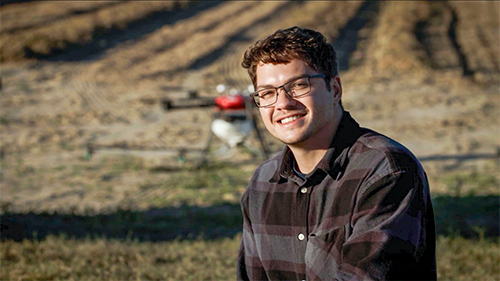Special permit first step for MSU research into drone pesticide application
Contact: Lexi Holdiness

STARKVILLE, Miss.—Mississippi State researchers are helping pave the way toward safe, effective pesticide application methods using uncrewed aerial vehicles, or UAVs.
Darrin Dodds, interim associate director of the Mississippi Agricultural and Forestry Experiment Station and head of MSU’s Department of Plant and Soil Sciences, explained that the technology exists but lacks research support.
“Over the last few years there has been increased interest in pesticide application from a UAV. There are many things we don’t yet know because this technology is so new and continually evolving,” Dodds said. “Our current aerial regulations for pesticides weren’t written to include UAV application.”
As such, the Mississippi Department of Agriculture and Commerce recently added a regulation allowing special use permits to be issued to MSU for this research. Hannah Ferguson, branch director of licensing and certification in MDAC’s Bureau of Plant Industry, worked closely with MSU to make this expanded pesticide research possible, and it now has received funding from the U.S. Department of Agriculture.
“Success in pesticide application is ensuring pesticide applicators make informed decisions. At this time, there is limited application information available for using UAVs to deliver pesticides. This MSU research will be a vital tool in developing future regulations,” Ferguson said.
Antonio Augusto Tavares, a Brazilian doctoral student working with Dodds on the project, is measuring the operation factors in UAV pesticide application.
“I haven’t used pesticides yet because of the regulations here in Mississippi, but with this special use permit I can start,” Tavares said. “There are so many factors like droplet size, speed of propellers, and downwash, the directional change of air from propellers, flight height and flight speed, that we have to research and find the best and safest method.”
By investigating the safest, most efficient ways to use UAVs to apply pesticides, the research will help build the foundation for more widespread pesticide research.
“We’re fortunate to have the relationship and cooperation we have with MDAC. The bureau has been extremely supportive and it’s nice to be able to come together as a team to meet the needs of our agricultural community,” Dodds said. “This is the first step in developing guidelines for producers to use on their fields.”
He said in addition to giving scientists the ability to evaluate pesticide applications via drones, the work will help determine guidelines for other research units and for this developing industry.
For more information about the Department of Plant and Soil Sciences in the College of Agriculture and Life Sciences, visit www.pss.msstate.edu. For more information about the Mississippi Agricultural and Forestry Experiment Station, visit www.mafes.msstate.edu. For more information about the Mississippi Department of Agriculture and Commerce or the Bureau of Plant Industry, visit www.mdac.ms.gov.
MSU is taking care of what matters. Learn more at www.msstate.edu.